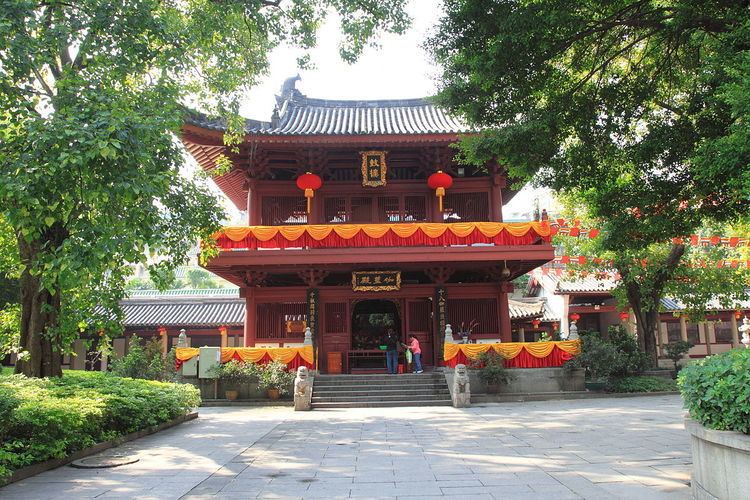Chinese 光孝寺 Wade–Giles Kuang¹-hsiao⁴ Szu⁴ | Hanyu Pinyin Jyutping Gwong¹-haau³ Zi⁶ Phone +86 20 8108 1977 | |
 | ||
Similar Temple of the Six Banyan T, Huaisheng Mosque, Chen Clan Ancestral Hall, Sun Yat‑sen Memorial, Zhenhai Tower | ||
Guangxiao Temple is one of the oldest Buddhist temples in Guangzhou, the capital of China's Guangdong Province. As the special geographical position, Guangxiao Temple often acted as a stopover point for Asian missionary monks in the past. It also played a central role in propagating various elements of Buddhism, including precepts school, Chan (Zen), esoteric (Shingon) Buddhism, and Pure Land. Particularly, Huineng, the sixth Chinese patriarch of Chan Buddhism, made his first public Chan lecture and was tonsured in Guangxiao Temple; Esoteric Buddhist master Amoghavajra’s first teaching of esoteric Buddhism is thought to have been in Guangxiao Temple. It was also a translation center in Southern China, where Buddhist scriptures were translated by Yijing and the Shurangama-sūtra was translated by Paramitiin--these texts served to promote the establishment of Mahāyāna Buddhism as the mainstream philosophy of Chinese (even Asia-Pacific) Buddhism. With the development of globalization, Guangxiao Temple is now exerting even more positive effects on the propagation of Buddhism via international communications and Buddhist tourism.[2]
Contents
History
Guangxiao originated from the residence of Zhao Jiande, the king of Nanyue whose usurpation prompted Emperor Wu of the Han to invade and annex the area. During the Three Kingdoms, the Wu officer and scholar Yu Fan (虞翻) was banished to live at the residence. After Yu Fan died in 233, his family donated the estate, whose grounds were organized as the Zhizhi Temple. It was repeatedly renamed: the Wangyuanchaoyan Temple, the Wangyuan Temple, the Qianmingfaxing Temple, the Chongningwanshou Temple, and the Baoenguangxiaochan Temple.
In 1482, the Chenghua Emperor of the Ming renamed it Guangxiao Temple and personally recorded the new name on a stele. Since then, the temple has kept the name “Guangxiao”.
Between the 4th and 10th centuries, many monks from South Asia (especially India) or mainland China came to the coastal Guangxiao Temple. During the period, Guangxiao Temple reached its peak. In the subsequent centuries, some eminent Chinese monks also visited or lived at Guangxiao Temple to propagate Buddhism, such as Danxiatianran (丹霞天然) and Yangshanhuiji (仰山慧寂).
In the 17th century, Guangxiao Temple fell into decline, although it underwent minor restoration several times. In the last two centuries, Guangxiao Temple was fatally damaged by the movement to “Requisition Temple Property to Promote Education” (廟產興學; 1898–1931) and the Cultural Revolution (1966–1976). Over this period, most of the buildings of Guangxiao Temple were either destroyed or occupied for secular usage.
In the 1980s, Guangxiao Temple was reoccupied by Buddhist monks. Since then, some of its main halls have been rebuilt, such as the Mahavira Hall, Samghrma Hall, and Ksitigarbha Hall. ‘Dharma pillars’ have also been erected in front of each hall. In addition, an animal liberation pond has recently been built near these structures. These reconstructed buildings have restored the beautiful scenery of Guangxiao Temple to some extent. However, the scale of the temple today is much smaller than in the past.
The temple's records are principally recorded in a thread-bound edition entitled The Annals of Guangxiao Temple, written in 1769.
Transportation
The temple is accessible within walking distance north of Ximenkou Station of Guangzhou Metro.
